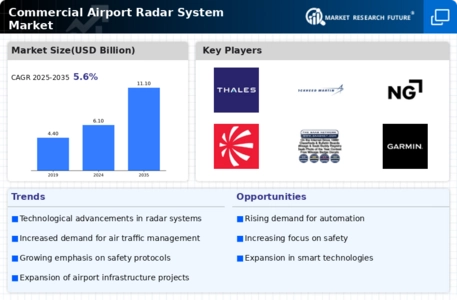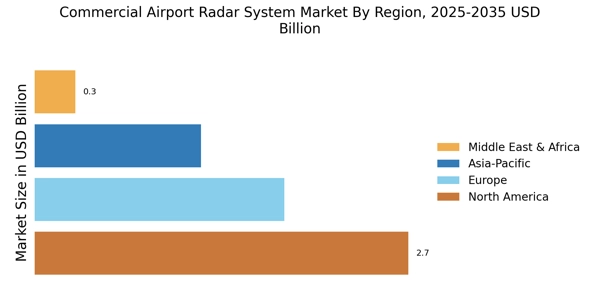Technological Innovations
Technological advancements play a crucial role in shaping the Commercial Airport Radar System Market. Innovations such as 3D radar systems, Automatic Dependent Surveillance-Broadcast (ADS-B), and advanced signal processing techniques are enhancing the capabilities of radar systems. These technologies improve tracking accuracy, reduce false alarms, and enable better integration with other air traffic management systems. The market is witnessing a shift towards more sophisticated radar solutions that can provide real-time data and analytics. As airports seek to modernize their infrastructure, the demand for cutting-edge radar technologies is expected to rise, driving growth in the Commercial Airport Radar System Market.
Focus on Safety and Security
The increasing emphasis on safety and security in aviation is a significant driver for the Commercial Airport Radar System Market. With the rise in air traffic, the need for robust safety measures has become paramount. Radar systems are essential for monitoring aircraft movements and ensuring safe landings and takeoffs. Regulatory bodies are continuously updating safety standards, which compels airports to adopt advanced radar technologies. The market is responding to this demand by offering systems that enhance situational awareness and reduce the risk of accidents. As safety remains a top priority for the aviation sector, the Commercial Airport Radar System Market is likely to experience sustained growth.
Increasing Air Traffic Demand
The rising demand for air travel is a primary driver of the Commercial Airport Radar System Market. As more passengers opt for air travel, airports are experiencing increased traffic volumes, necessitating advanced radar systems to manage airspace efficiently. According to recent data, air traffic is projected to grow at a compound annual growth rate of approximately 4.5% over the next decade. This growth compels airports to invest in modern radar technologies to enhance safety and operational efficiency. The Commercial Airport Radar System Market is thus likely to see a surge in demand as airports strive to accommodate this influx of air traffic while maintaining high safety standards.
Government Investments in Airport Infrastructure
Government initiatives aimed at upgrading airport infrastructure significantly influence the Commercial Airport Radar System Market. Many countries are investing heavily in modernizing their airports to enhance safety and efficiency. For instance, recent government reports indicate that several nations are allocating substantial budgets for airport upgrades, including the installation of advanced radar systems. This trend is likely to continue as governments recognize the importance of efficient air traffic management in supporting economic growth. Consequently, the Commercial Airport Radar System Market stands to benefit from these investments, as airports seek to implement state-of-the-art radar technologies to meet regulatory requirements and improve operational performance.
Environmental Regulations and Sustainability Goals
The push for sustainability and adherence to environmental regulations are increasingly influencing the Commercial Airport Radar System Market. Airports are under pressure to minimize their environmental impact, leading to the adoption of radar systems that optimize flight paths and reduce fuel consumption. Advanced radar technologies can facilitate more efficient air traffic management, which in turn lowers emissions. As regulatory frameworks become stricter regarding environmental performance, airports are likely to invest in radar systems that align with sustainability goals. This trend not only supports compliance with regulations but also enhances the overall efficiency of airport operations, thereby driving growth in the Commercial Airport Radar System Market.


















Leave a Comment